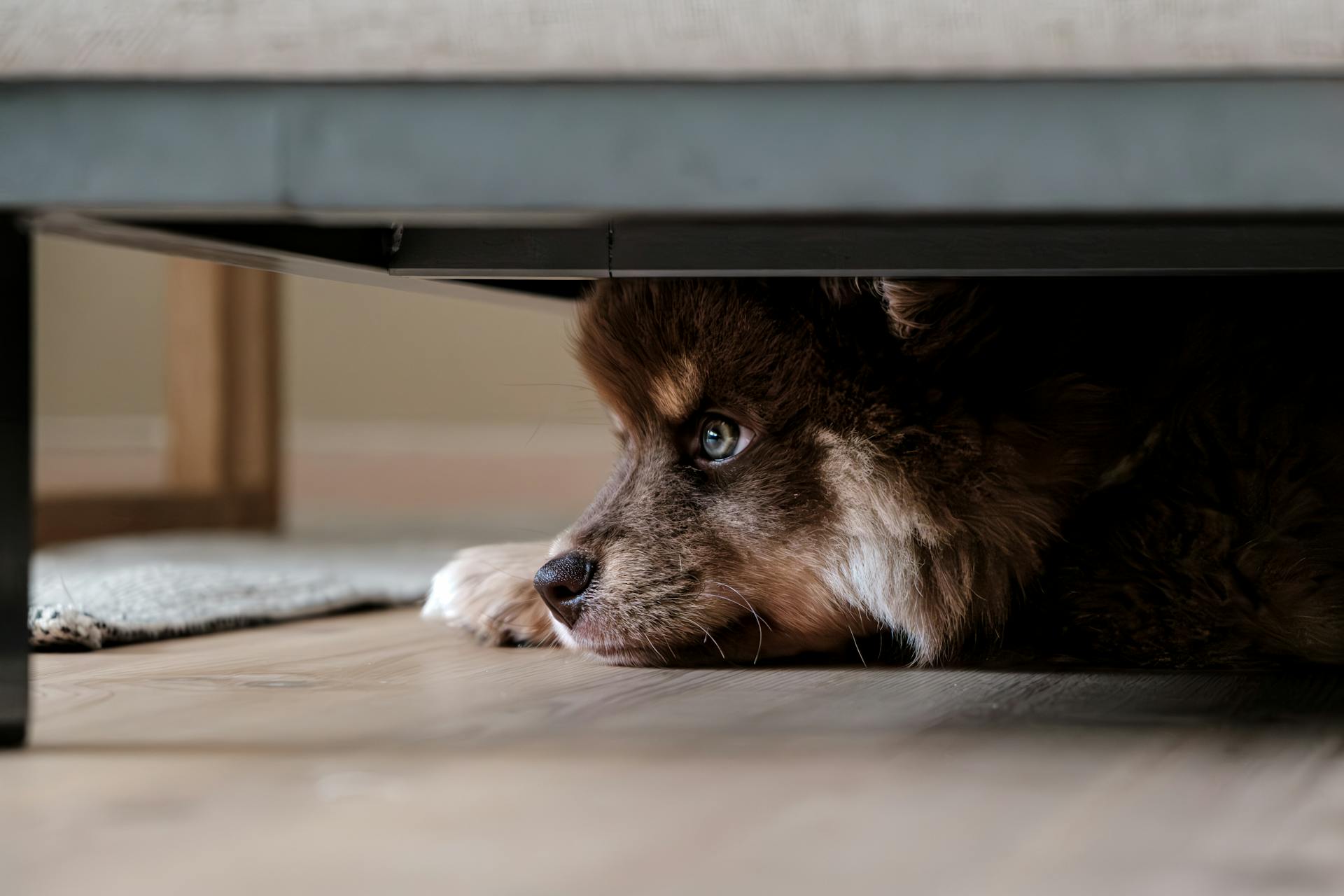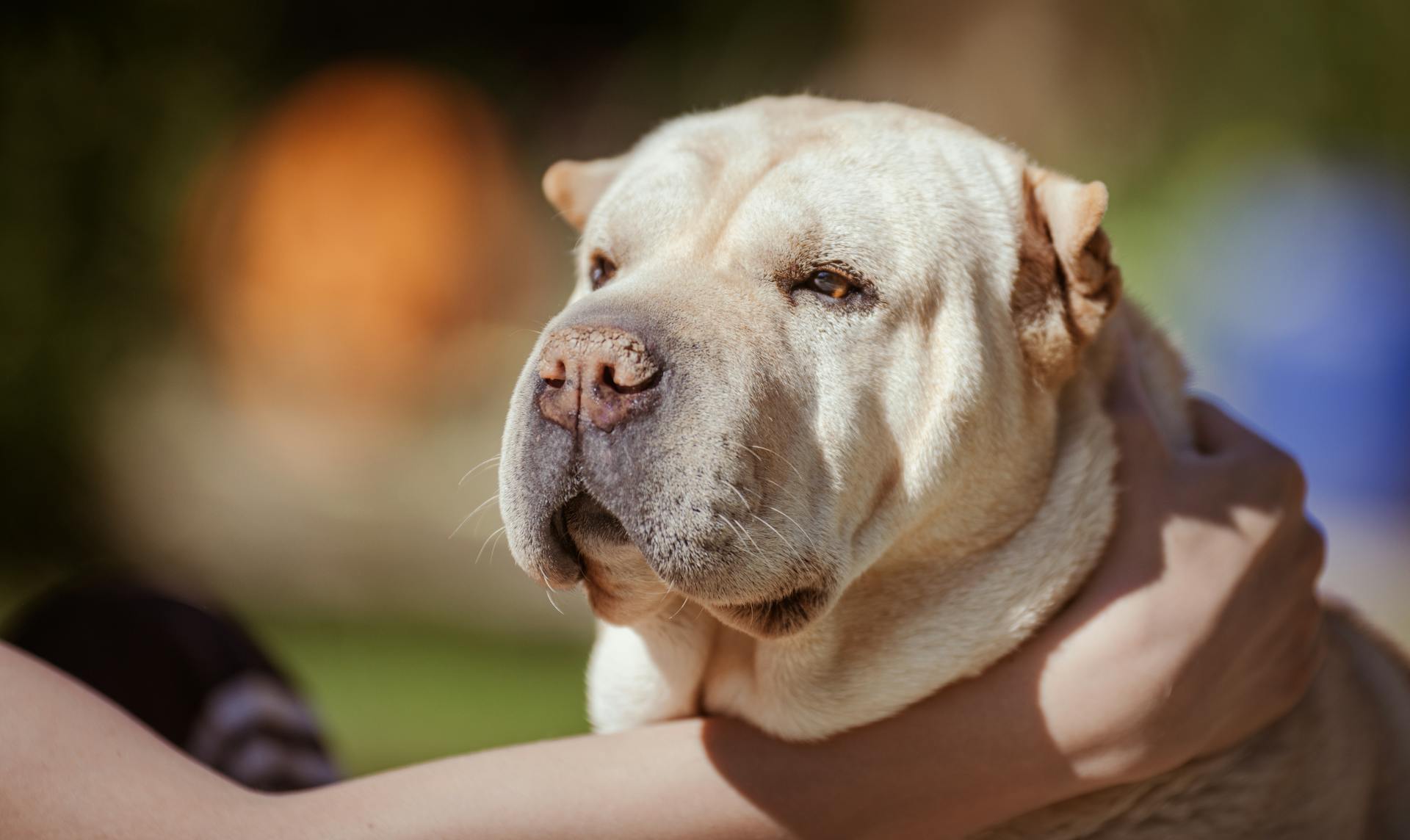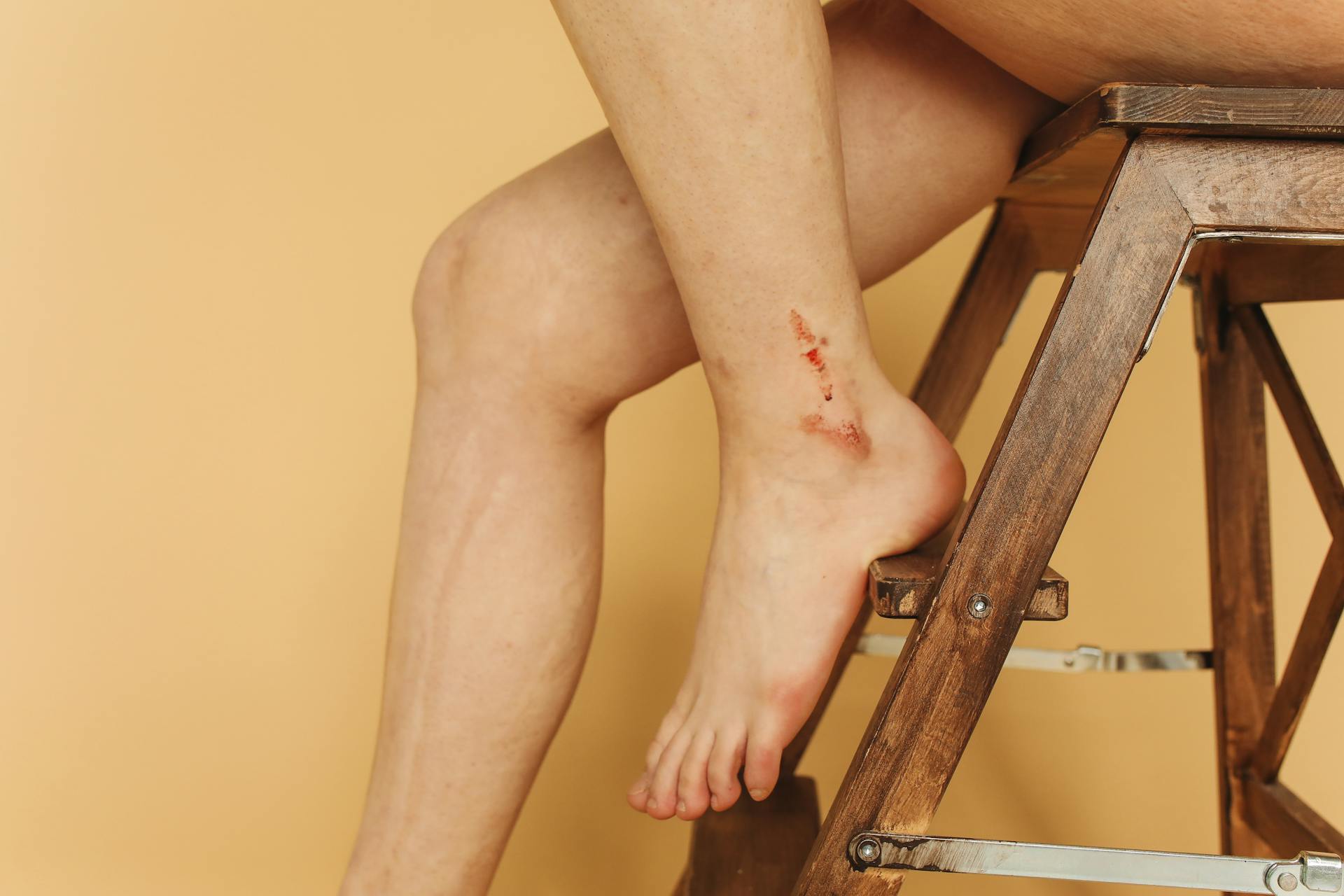
If your dog is licking a lump on their leg, it's essential to understand the underlying issues that might be causing this behavior.
The lump could be a sign of an allergic reaction, which can cause intense itching and discomfort for your dog.
Allergic reactions can be triggered by a variety of factors, including skin allergies, food allergies, or environmental allergies.
In some cases, the lump may be a sign of a more serious underlying condition, such as a skin infection or a tumor.
Skin infections are a common issue in dogs and can be caused by bacteria, yeast, or other microorganisms.
A fresh viewpoint: Paw Licking in Dogs Allergies
Causes and Symptoms
A dog licking lump on leg can be a concerning sight. The lump can be a sebaceous cyst, which is a common skin growth that can appear on a dog's leg.
Sebaceous cysts can vary in appearance, but they often present as a raised area of skin or a nodule. They can be round or elongated, and some may be slightly mobile under the skin. The size of the cyst can range from less than ½ an inch to over 2 inches in diameter.
A sebaceous cyst can be caused by a blockage of a follicle opening, similar to a blocked pore in humans. It can also be caused by genetic predisposition, injury or trauma, or an allergic reaction.
In some cases, a sebaceous cyst can become infected, leading to inflammation and a foul odor. If you notice any of these symptoms, it's essential to have your dog checked by a veterinarian.
Another possible cause of a lump on a dog's leg is a lick granuloma. This is a skin condition caused by compulsive licking of a single area, often on the front of the lower leg. The area may become open and scabbed over, or it may form a lump or large bump.
The causes of lick granuloma are varied, but it's often linked to anxiety or nervous habits. If you suspect your dog has a lick granuloma, it's crucial to discourage the licking behavior to allow the area to heal.
Here are some common causes of lumps on dog legs:
- Sebaceous cysts
- Lick granuloma
- Acral lick dermatitis
- Hormonal imbalance
- Swollen hair follicle
- Genetic predisposition
- Blockage of a follicle opening
- Injury or trauma
- Insect bite reaction
- Allergic reaction
- Follicular inactivity
- Lack of sebum secretion
Diagnosis
Diagnosis is the first step in figuring out what's going on with your dog's lump on their leg. Your veterinarian will carefully check the entire body of your furry family member to determine the location, number, and appearance of the cysts.
They'll use a combination of observation and testing to determine the type of mass. Just because it looks like a sebaceous cyst doesn't always mean it is one. Your vet will perform additional testing to determine the type of mass.
Histopathology is the best method of evaluating the tissues that make up the cyst, which involves a microscopic examination of the tissue. This can be done by removing the tissue with a needle aspirate for biopsy, or completely extracting it surgically.
A fine needle aspiration (FNA) test may also be recommended by your veterinarian to collect the material and/or cells within the mass. This is useful for a wide variety of skin tumors, but may not always yield a clear diagnosis for smaller or firmer skin cysts.
It's essential to get an accurate diagnosis so the condition can be treated. If your dog is scratching or licking excessively, or if you notice any changes in their coat or skin, you should see your veterinarian.
Treatment and Recovery
Treatment for a dog licking a lump on their leg will depend on the state of the lump, the number of lumps, and the health condition of your pet.
The veterinarian may take a wait and see approach if the lump appears relatively new, delaying treatment until it develops further.
If the lump ruptures, the veterinarian may treat any inflammation or infection present, and then surgically remove the lump.
With sebaceous gland overgrowth or adenoma, recurrence is common, and the prognosis of removal is usually good, but the recurrence factor must be kept in mind.
After treatment, your dog will need to keep the area clean and not bathe until the veterinary caregiver gives permission.
Your dog may have to wear an Elizabethan collar to prevent licking or biting the area as it heals.
Check the surgery site daily for swelling, redness, or bleeding, and consult with the veterinary team if you're unsure of the condition of the surgery site.
Here's an interesting read: Dog Lump Removal Surgery Recovery
At Home Treatment

Treating sebaceous cysts is primarily the job of your veterinarian.
Most at-home treatments won't resolve a sebaceous cyst entirely.
There aren't many treatments that will help prevent sebaceous cysts from occurring.
General skin care can make a huge difference in the life of your furry (or hairless) friend.
Treatment
Treatment is a crucial step in managing sebaceous cysts in dogs.
The approach to treatment depends on the state of the cysts, the number of cysts, and the overall health of your pet.
If the cyst is relatively new, a wait and see approach may be taken, delaying treatment until the cyst develops further.
The veterinarian may choose to open and drain the cyst and treat it with a topical medication at a later time.
If the cyst has ruptured, the veterinarian may treat any inflammation or infection present, and then surgically remove the cyst.
Surgical removal may not be an easy task if many cysts are present.
Recurrence is common with sebaceous gland overgrowth or adenoma, so the prognosis of removal is usually good, but the possibility of recurrence must be kept in mind.
Broaden your view: Dog Lump Removal Surgery Cost
Recovery

Recovery is a crucial part of the healing process for your dog.
The area where the cysts were located will eventually heal, but it's not uncommon for them to resurface, or for new cysts to appear.
You'll need to keep the area clean and avoid bathing your dog until your veterinarian gives permission.
Your dog may have to wear an Elizabethan collar to prevent him from licking or biting the area as it heals.
Check the surgery site daily for swelling, redness, or bleeding, and consult with your veterinarian if you're unsure of the condition or if the wound is not improving.
Your veterinarian may prescribe additional topical medication or antibiotics if necessary.
A fresh viewpoint: Dog Groin Lump
Common Lumps and Conditions
Common lumps on a dog's skin are often benign and can be identified by a vet. Lipomas, also known as fatty tumors, are the most common cause of lumps and bumps on a dog's skin.
These lumps are usually found in adult and senior dogs, especially in larger breeds and those who are overweight. Lipomas are not painful and grow very slowly.
If a lipoma grows in an area that impacts a dog's mobility, it may need to be removed; otherwise, it can be left alone and monitored.
On a similar theme: How Much Does It Cost to Amputate a Dog's Leg?
Acral Lick Granuloma
Acral Lick Granuloma is a frustrating skin condition caused by compulsive licking of a single area, often on the front of the lower leg. This can lead to chronic pain and itching, causing the dog to keep licking the same spot.
The area is unable to heal, making it a challenging condition to manage. Treatment typically involves discouraging the dog from licking the affected area.
Using a bad-tasting topical solution or an Elizabethan collar can be effective in stopping the licking habit. Your vet may also recommend other treatment options.
Common Lumps
Most lumps on dogs are benign, which means they're not cancerous. Your vet can often identify them straight away.
Some common lumps on dogs include lipomas, which are benign fatty tumors that occur in adult and senior dogs, especially larger breeds and overweight dogs. They're not painful and grow very slowly.
Lipomas can be left alone and monitored, but if they grow in an area that impacts mobility, they may need to be removed. Some pet owners choose to remove them for aesthetic reasons.
Intriguing read: Benign Lump on Dog

Histiocytomas are fast-growing, pink button-like lumps that often appear in dogs under a year of age. They'll usually stop growing and shrink on their own within two weeks.
If a histiocytoma doesn't start shrinking within two weeks, it's often removed just to be sure. A fine needle aspiration and the age of the dog can help diagnose a histiocytoma.
Explore further: Dog Lump with Hair Growing Out of It
Follicular
Follicular cysts are rare skin lumps caused by dilation and rupture of hair follicles.
They may look like tumours, but don't worry, they're benign and usually easy for your vet to remove under anaesthetic.
Frequently Asked Questions
Why does my dog have a bump on her leg?
A lump on your dog's leg could be caused by a variety of factors, including fat, tumors, cysts, or infections. If you're concerned about your dog's bump, it's best to consult with a veterinarian for a proper diagnosis and treatment.
Featured Images: pexels.com


